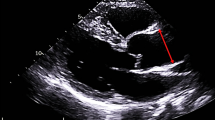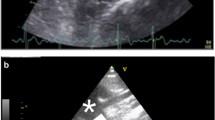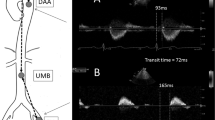Abstract
Predictors of aortic pulse wave velocity (AoPWV) were not previously studied in the elderly with severe aortic stenosis (AS). We aimed to compare the AoPWV in these patients with matched controls and to study the predictors of AoPWV in this population. We measured the AoPWV during cardiac catheterisation in 40 patients with severe AS and 20 matched controls. AoPWV in both groups was similar (p = 0.198) and lied within normal reference value for age in 68 % of elderly with severe AS. Central systolic blood pressure (SBP) (adjusted β = 0.45, p = 0.001) and glomerular filtration rate (GFR) (adjusted β = −0.29, p = 0.023) were the only independent predictors of AoPWV in AS group. Central SBP >140 mmHg was the best predictor of abnormal AoPWV (≥14.6 m/s) with 100 % sensitivity and 70 % specificity, p < 0.001. Conclusion: AoPWV is not increased in the elderly with severe AS compared to controls, and lies within the reference value for age in the majority of these patients. Central SBP >140 mmHg best predicts abnormal AoPWV in the elderly with severe AS.


Similar content being viewed by others
References
Hachicha Z, Dumesnil JG, Bogaty P et al (2007) Paradoxical low-flow, low-gradient severe aortic stenosis despite preserved ejection fraction is associated with higher afterload and reduced survival. Circulation 115:2856–2864
Hachicha Z, Dumesnil JG, Pibarot P (2009) Usefulness of the valvuloarterial impedance to predict adverse outcome in asymptomatic aortic stenosis. J Am Coll Cardiol 54:1003–1011
Katsanos S, Yiu KH, Clavel MA et al (2013) Impact of valvuloarterial impedance on 2-year outcome of patients undergoing transcatheter aortic valve implantation. J Am Soc Echocardiogr Off Publ Am Soc Echocardiogr 26:691–698
Sutton-Tyrrell K, Najjar SS, Boudreau RM et al (2005) Elevated aortic pulse wave velocity, a marker of arterial stiffness, predicts cardiovascular events in well-functioning older adults. Circulation 111:3384–3390
Willum-Hansen T, Staessen JA, Torp-Pedersen C et al (2006) Prognostic value of aortic pulse wave velocity as index of arterial stiffness in the general population. Circulation 113:664–670
Reference Values for Arterial Stiffness (2010) C: determinants of pulse wave velocity in healthy people and in the presence of cardiovascular risk factors: ‘establishing normal and reference values’. Eur Heart J 31:2338–2350
Liu PY, Tsai WC, Lin CC et al (2004) Invasive measurements of pulse wave velocity correlate with the degree of aortic valve calcification and severity associated with matrix metalloproteinases in elderly patients with aortic valve stenosis. Clin Sci 107:415–422
Nemes A, Galema TW, Geleijnse ML et al (2007) Aortic valve replacement for aortic stenosis is associated with improved aortic distensibility at long-term follow-up. Am Heart J 153:147–151
Vavuranakis M, Vrachatis DA, Boudoulas H et al (2012) Effect of transcatheter aortic valve implantation on the ascending aorta’s elasticity. Clin Res Cardiol Off J German Cardiac Soc 101:895–899
Pagel PS, Schroeder AR, De Vry DJ, et al (2014) Aortic Valve Replacement Reduces Valvuloarterial Impedance but Does Not Affect Systemic Arterial Compliance in Elderly Men with Degenerative Calcific Trileaflet Aortic Valve Stenosis. J Cardiothoracic Vasc Anesthesia 28:1540–1544
Wallace SM, Yasmin Y, McEniery CM et al (2007) Isolated systolic hypertension is characterized by increased aortic stiffness and endothelial dysfunction. Hypertension 50:228–233
Cecelja M, Chowienczyk P (2009) Dissociation of aortic pulse wave velocity with risk factors for cardiovascular disease other than hypertension: a systematic review. Hypertension 54:1328–1336
Verwoert GC, Franco OH, Hoeks AP, et al (2014) Arterial stiffness and hypertension in a large population of untreated individuals: the Rotterdam Study. J Hypertens 32:1606–1612
Wang MC, Tsai WC, Chen JY et al (2005) Stepwise increase in arterial stiffness corresponding with the stages of chronic kidney disease. Am J Kidney Dis Off J Nat Kidney Foundation 45:494–501
Briet M, Bozec E, Laurent S et al (2006) Arterial stiffness and enlargement in mild-to-moderate chronic kidney disease. Kidney Int 69:350–357
Chue CD, Townend JN, Steeds RP et al (2010) Arterial stiffness in chronic kidney disease: causes and consequences. Heart 96:817–823
Townsend RR, Wimmer NJ, Chirinos JA et al (2010) Aortic PWV in chronic kidney disease: a CRIC ancillary study. Am J Hypertens 23:282–289
Moody WE, Edwards NC, Chue CD et al (2013) Arterial disease in chronic kidney disease. Heart 99:365–372
Zoghbi WA, Enriquez-Sarano M, Foster E et al (2003) Recommendations for evaluation of the severity of native valvular regurgitation with two-dimensional and Doppler echocardiography. J Am Soc Echocardiogr Off Publ Am Soc Echocardiogr 16:777–802
Levey AS, Coresh J, Greene T et al (2006) Using standardized serum creatinine values in the modification of diet in renal disease study equation for estimating glomerular filtration rate. Ann Intern Med 145:247–254
Broberg CS, Therrien J (2015) Understanding and treating aortopathy in bicuspid aortic valve. Trends Cardiovasc Med 25:445–451
Alecu C, Labat C, Kearney-Schwartz A et al (2008) Reference values of aortic pulse wave velocity in the elderly. J Hypertens 26:2207–2212
Briand M, Dumesnil JG, Kadem L et al (2005) Reduced systemic arterial compliance impacts significantly on left ventricular afterload and function in aortic stenosis: implications for diagnosis and treatment. J Am Coll Cardiol 46:291–298
Mohty D, Magne J, Deltreuil M et al (2013) Outcome and impact of surgery in paradoxical low-flow, low-gradient severe aortic stenosis and preserved left ventricular ejection fraction: a cardiac catheterization study. Circulation 128:S235–S242
Rossi SH, McQuarrie EP, Miller WH et al (2013) Impaired renal function impacts negatively on vascular stiffness in patients with coronary artery disease. BMC Nephrol 14:173
Schillaci G, Pirro M, Mannarino MR et al (2006) Relation between renal function within the normal range and central and peripheral arterial stiffness in hypertension. Hypertension 48:616–621
Weber T, Ammer M, Rammer M et al (2009) Noninvasive determination of carotid-femoral pulse wave velocity depends critically on assessment of travel distance: a comparison with invasive measurement. J Hypertens 27:1624–1630
Author information
Authors and Affiliations
Corresponding author
Ethics declarations
Conflict of interest
On behalf of all authors, the corresponding author states that there is no conflict of interest.
Ethical approval
The study was performed in compliance with the ethical standards of declaration of Helsenki and its amendments and the institutional ethical standards of Essen University Hospital.
Informed consent
Informed consent was obtained from all participants or their legal representatives prior to inclusion in the study.
Rights and permissions
About this article
Cite this article
El-Chilali, K., Farouk, H., Abdelhafez, M. et al. Predictors of aortic pulse wave velocity in the elderly with severe aortic stenosis. Aging Clin Exp Res 28, 519–525 (2016). https://doi.org/10.1007/s40520-015-0443-z
Received:
Accepted:
Published:
Issue Date:
DOI: https://doi.org/10.1007/s40520-015-0443-z




